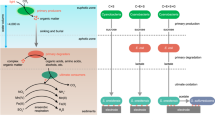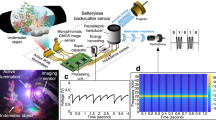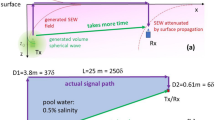Abstract
Our oceans are vast, mostly unexplored and difficult to monitor. Large-scale implementation of a fully autonomous ‘Internet of Underwater Things’ would transform how we collect and share data from this domain; however, deployment is prohibited by the lack of persistent power sources. In principle, underwater solar-energy generation can complement the use of batteries and provide a solution, although dedicated research is needed since traditional silicon solar cells do not perform well underwater due to water’s strong absorption of near-infrared light. In this Perspective we present examples of solar-powered underwater applications and discuss which types of solar-harvesting materials could be appropriate, including GaInP variants, CdTe, organic semiconductors, and perovskite semiconductors. We also discuss challenges that need to be addressed, such as the development of effective antifouling coatings and new certification standards given that underwater conditions are starkly different from those in terrestrial environments.
This is a preview of subscription content, access via your institution
Access options
Access Nature and 54 other Nature Portfolio journals
Get Nature+, our best-value online-access subscription
$29.99 / 30 days
cancel any time
Subscribe to this journal
Receive 12 print issues and online access
$209.00 per year
only $17.42 per issue
Buy this article
- Purchase on Springer Link
- Instant access to full article PDF
Prices may be subject to local taxes which are calculated during checkout




Similar content being viewed by others
References
Wang, X. Reviews of power systems and environmental energy conversion for unmanned underwater vehicles. Renew. Sustain. Energy Rev. 16, 1958–1970 (2012).
Jenkins, P. & Walters, R. Photovoltaic technology for Navy and Marine Corps applications. In Proc. 2017 IEEE 60th International Midwest Symposium on Circuits and Systems (MWSCAS) 958–961 (IEEE, 2017)
Driscol, B. P., Gish, L. A. & Coe, R. G. A scoping study to determine the location-specific WEC threshold size for wave-powered AUV recharging. IEEE J. Ocean. Eng. 46, 1–10 (2021).
Domingo, M. C. An overview of the internet of underwater things. J. Netw. Comput. Appl. 35, 1879–1890 (2012).
Delphin Raj, K. M. et al. Underwater network management system in internet of underwater things: open challenges, benefits, and feasible solution. Electronics 9, 1142 (2020).
Chen, H. et al. Attraction, challenge and current status of marine current energy. IEEE Access 6, 12665–12685 (2018).
Melikoglu, M. Current status and future of ocean energy sources: a global review. Ocean Eng. 148, 563–573 (2018).
Wang, G., Yang, Y. & Wang, S. Ocean thermal energy application technologies for unmanned underwater vehicles: a comprehensive review. Appl. Energy 278, 115752 (2020).
Hahn, G. G., Adoram-Kershner, L. A., Cantin, H. P. & Shafer, M. W. Assessing solar power for globally migrating marine and submarine systems. IEEE J. Ocean. Eng. 44, 693–706 (2019).
Smith, R. C. & Baker, K. S. Optical properties of the natural waters (200–800 nm). Appl. Opt. 20, 177–184 (1981).
Mishra, D. R., Narumalani, S., Rundquist, D. & Lawson, M. Characterizing the vertical diffuse attenuation coefficient for downwelling irradiance in coastal waters: implications for water penetration by high resolution satellite data. ISPRS J. Photogramm. Remote Sens. 60, 48–64 (2005).
Morel, A. et al. Optical properties of the ‘clearest’ natural waters. Limnol. Oceanogr. 52, 217–229 (2007).
Röhr, J. A., Lipton, J., Kong, J., Stephen, A. & Taylor, A. D. Efficiency limits of underwater solar cells. Joule 4, 840–849 (2020).
Jenkins, P. P. et al. High-bandgap solar cells for underwater photovoltaic applications. IEEE J. Photovolt. 4, 202–207 (2014).
Ageev, M. D. & Blidberg, D. R. Current progress in the development of a solar powered autonomous underwater vehicle (AUV). In Proc. 1998 International Symposium on Underwater Technology 145–149 (IEEE, 1998).
Jalbert, J. et al. A solar-powered autonomous underwater vehicle. In Proc. Oceans 2003. Celebrating the Past.Teaming Toward the Future 1132–1140 (IEEE, 2003).
Blidberg, D. R., Chappell, S. & Jalbert, J. C. Long endurance sampling of the ocean with solar powered AUV’s. IFAC Proc. Vol. 37, 561–566 (2004).
Crimmins, D. M. et al. Long-endurance test results of the solar-powered AUV system. In Proc. OCEANS 2006 (IEEE, 2006); https://doi.org/10.1109/OCEANS.2006.306997
Abdellatif, M. M., Maher, S. M., Al-Sayyad, G. M. & Abdellatif, S. O. Implementation of a low cost, solar charged RF modem for underwater wireless sensor networks. Int. J. Smart Sens. Intell. Syst. 13, 1–11 (2020).
Röhr, J. A. et al. Identifying optimal photovoltaic technologies for underwater applications. iScience 25, 104531 (2022).
Joshi, K. B., Costello, J. H. & Priya, S. Estimation of solar energy harvested for autonomous jellyfish vehicles (AJVs). IEEE J. Ocean. Eng. 36, 539–551 (2011).
Arima, M., Okashima, T. & Yamada, T. Development of a solar-powered underwater glider. In Proc. 2011 IEEE Symposium on Underwater Technology and Workshop on Scientific Use of Submarine Cables and Related Technologies (IEEE, 2011); https://doi.org/10.1109/UT.2011.5774120
Enaganti, P. K., Dwivedi, P. K., Sudha, R., Srivastava, A. K. & Goel, S. Underwater characterization and monitoring of amorphous and monocrystalline solar cells in diverse water settings. IEEE Sens. J. 20, 2730–2737 (2020).
Kong, M. et al. Toward self-powered and reliable visible light communication using amorphous silicon thin-film solar cells. Opt. Express 27, 34542–34551 (2019).
Mowbray, D. J., Kowalski, O. P., Hopkinson, M., Skolnick, M. S. & David, J. P. R. Electronic band structure of AlGaInP grown by solid-source molecular-beam epitaxy. Appl. Phys. Lett. 65, 213–215 (1994).
Perl, E. E. et al. Development of high-bandgap AlGaInP solar cells grown by organometallic vapor-phase epitaxy. IEEE J. Photovolt. 6, 770–776 (2016).
Simon, J. et al. III-V-based optoelectronics with low-cost dynamic hydride vapor phase epitaxy. Crystals (Basel) 9, 3 (2019).
Riede, M., Spoltore, D. & Leo, K. Organic solar cells—the path to commercial success. Adv. Energy Mater. 11, 2002653 (2021).
Kim, S., Jahandar, M., Jeong, J. H. & Lim, D. C. Recent progress in solar cell technology for low-light indoor applications. Curr. Altern. Energy 3, 3–17 (2019).
Ma, L. K. et al. High-efficiency indoor organic photovoltaics with a band-aligned interlayer. Joule 4, 1486–1500 (2020).
Walters, R. J. et al. Multijunction organic photovoltaic cells for underwater solar power. In Proc. 2015 IEEE 42nd Photovoltaic Specialist Conference (PVSC) (IEEE, 2015); https://doi.org/10.1109/PVSC.2015.7355644
Lee, H. K. H. et al. The role of fullerenes in the environmental stability of polymer:fullerene solar cells. Energy Environ. Sci. 11, 417–428 (2018).
Speller, E. M. et al. From fullerene acceptors to non-fullerene acceptors: prospects and challenges in the stability of organic solar cells. J. Mater. Chem. A 7, 23361–23377 (2019).
Bi, P. et al. Reduced non-radiative charge recombination enables organic photovoltaic cell approaching 19% efficiency. Joule 5, 2408–2419 (2021).
Zhu, L. et al. Single-junction organic solar cells with over 19% efficiency enabled by a refined double-fibril network morphology. Nat. Mater. 21, 656–663 (2022).
Yuan, J. et al. Single-junction organic solar cell with over 15% efficiency using fused-ring acceptor with electron-deficient core. Joule 3, 1140–1151 (2019).
Fei, Z. et al. An alkylated indacenodithieno[3,2‐b]thiophene‐based nonfullerene acceptor with high crystallinity exhibiting single junction solar cell efficiencies greater than 13% with low voltage losses. Adv. Mater. 30, 1705209 (2018).
Li, S. et al. A wide band gap polymer with a deep highest occupied molecular orbital level enables 14.2% efficiency in polymer solar cells. J. Am. Chem. Soc. 140, 7159–7167 (2018).
Chouhan, L., Ghimire, S., Subrahmanyam, C., Miyasaka, T. & Biju, V. Synthesis, optoelectronic properties and applications of halide perovskites. Chem. Soc. Rev. 49, 2869–2885 (2020).
Yoo, J. J. et al. Efficient perovskite solar cells via improved carrier management. Nature 590, 587–593 (2021).
Almora, O. et al. Device performance of emerging photovoltaic materials (version 2). Adv. Energy Mater. 11, 2102526 (2021).
Liu, C. et al. Promising applications of wide bandgap inorganic perovskites in underwater photovoltaic cells. Sol. Energy 233, 489–493 (2022).
Ke, W. & Kanatzidis, M. G. Prospects for low-toxicity lead-free perovskite solar cells. Nat. Commun. 10, 965 (2019).
Leguy, A. M. A. et al. Reversible hydration of CH3NH3PbI3 in films, single crystals, and solar cells. Chem. Mater. 27, 3397–3407 (2015).
Babayigit, A., Ethirajan, A., Muller, M. & Conings, B. Toxicity of organometal halide perovskite solar cells. Nat. Mater. 15, 247–251 (2016).
Jiang, Y. et al. Reduction of lead leakage from damaged lead halide perovskite solar modules using self-healing polymer-based encapsulation. Nat. Energy 4, 585–593 (2019).
Chen, H. et al. Ultra-high moisture stability perovskite films, soaking in water over 360 min. Chem. Eng. J. 450, 138028 (2022).
Lanzetta, L., Webb, T., Marin-Beloqui, J., Macdonald, T. & Haque, S. Halide chemistry in tin perovskite optoelectronics: bottlenecks and opportunities. Angew. Chem. Int. Ed. https://doi.org/10.1002/anie.202213966 (2022).
Sanchez-Diaz, J. et al. Tin perovskite solar cells with >1,300 h of operational stability in N2 through a synergistic chemical engineering approach. Joule 6, 861–883 (2022).
Enaganti, P. K. et al. Performance analysis of submerged polycrystalline photovoltaic cell in varying water conditions. IEEE J. Photovolt. 10, 531–538 (2020).
Xie, Q., Pan, J., Ma, C. & Zhang, G. Dynamic surface antifouling: mechanism and systems. Soft Matter 15, 1087–1107 (2018).
Cao, S., Wang, J. D., Chen, H. S. & Chen, D. R. Progress of marine biofouling and antifouling technologies. Chin. Sci. Bull. 56, 598–612 (2011).
Yebra, D. M., Kiil, S. & Dam-Johansen, K. Antifouling technology—past, present and future steps towards efficient and environmentally friendly antifouling coatings. Prog. Org. Coat. 50, 75–104 (2004).
Blidberg, D. R., Jalbert, J. & Ageev, M. D. The AUSI/IMTP solar powered autonomous undersea vehicle. In Proc. IEEE Oceanic Engineering Society OCEANS’98 Conference 363–368 (IEEE, 1998).
Ageev, M. D., Blidberg, D. R., Jalbert, J., Melchin, C. J. & Troop, D. P. Results of the evaluation and testing of the solar powered AUV and its subsystems. In Proc. IEEE Symposium on Autonomous Underwater Vehicle Technology 137–145 (IEEE, 2002).
Lobe, H., Haldeman, C. & Glenn, S. M. ClearSignal coating controls biofouling on the Rutgers glider crossing. Sea Technol. 51, 31–36 (2010).
Chen, R. et al. Transparent polymer–ceramic hybrid antifouling coating with superior mechanical properties. Adv. Funct. Mater. 31, 2011145 (2021).
Sunny, S. et al. Transparent antifouling material for improved operative field visibility in endoscopy. Proc. Natl Acad. Sci. USA 113, 11676–11681 (2016).
Baran, D. et al. Reducing the efficiency–stability–cost gap of organic photovoltaics with highly efficient and stable small molecule acceptor ternary solar cells. Nat. Mater. 16, 363–369 (2017).
Acknowledgements
The authors are grateful for funding from New York University and from the US Department of Energy, Solar Energy Technologies Office under agreement DE-EE0009829.
Author information
Authors and Affiliations
Corresponding authors
Ethics declarations
Competing interests
The authors declare no competing interests.
Peer review
Peer review information
Nature Photonics thanks the anonymous reviewers for their contribution to the peer review of this work.
Additional information
Publisher’s note Springer Nature remains neutral with regard to jurisdictional claims in published maps and institutional affiliations.
Rights and permissions
Springer Nature or its licensor (e.g. a society or other partner) holds exclusive rights to this article under a publishing agreement with the author(s) or other rightsholder(s); author self-archiving of the accepted manuscript version of this article is solely governed by the terms of such publishing agreement and applicable law.
About this article
Cite this article
Röhr, J.A., Sartor, B.E., Lipton, J. et al. A dive into underwater solar cells. Nat. Photon. 17, 747–754 (2023). https://doi.org/10.1038/s41566-023-01276-z
Received:
Accepted:
Published:
Issue Date:
DOI: https://doi.org/10.1038/s41566-023-01276-z
This article is cited by
-
Transparent integrated pyroelectric-photovoltaic structure for photo-thermo hybrid power generation
Nature Communications (2024)



